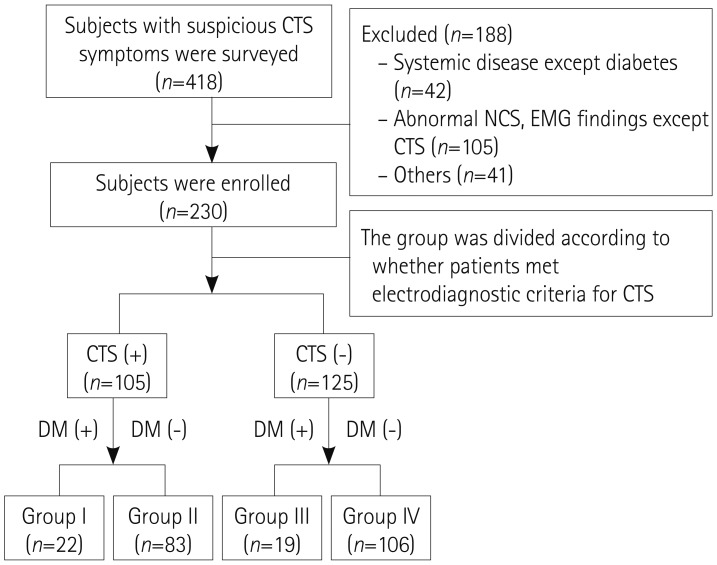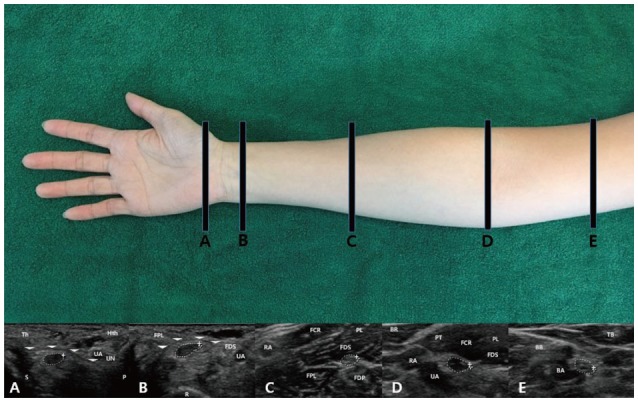J Clin Neurol.
2017 Jul;13(3):243-249. 10.3988/jcn.2017.13.3.243.
Does Diabetes Mellitus Influence Carpal Tunnel Syndrome?
- Affiliations
-
- 1Department of Neurology, Korea University Anam Hospital, Korea University College of Medicine, Seoul, Korea. nukbj@korea.ac.kr
- 2Department of Neurology, Hangang Sacred Heart Hospital, Hallym University Medical Center, Seoul, Korea.
- 3Department of Biostatistics, Korea University College of Medicine, Seoul, Korea.
- 4Neurophysiology Laboratory, Korea University Anam Hospital, Seoul, Korea.
- 5Brain Convergence Research Center, Korea University Anam Hospital, Seoul, Korea.
- KMID: 2391667
- DOI: http://doi.org/10.3988/jcn.2017.13.3.243
Abstract
- BACKGROUND AND PURPOSE
Diabetes mellitus (DM) has been proposed as a risk factor for carpal tunnel syndrome (CTS), but this remains controversial. We investigated the association between DM and CTS using both ultrasonography (US) and nerve conduction study (NCS) data.
METHODS
We analyzed a prospectively recruited database of neuromuscular US and medical records of subjects who had undergone NCSs and electromyography for symptoms suggestive of CTS. Subjects were assigned to the follow groups: Group I, CTS with DM; Group II, CTS without DM; Group III, no CTS with DM; and Group IV, no CTS without DM. US cross-sectional area (CSA) and NCS measurements at the median nerve (MN) were compared among groups. We used a general linear mixed model to adjust for statistically significant covariates.
RESULTS
The 230 participants comprised 22, 83, 19, and 106 in Groups I-IV, respectively. In multivariate analyses, the MN action potential amplitude in females was the only variable that was significantly associated with DM (p<0.001). Groups with DM tended to have a longer latency, smaller amplitude, and lower conduction velocity in the NCSs compared to groups without DM. The measured US CSA values did not differ significantly among the groups.
CONCLUSIONS
NCS measurements of the MN tended to differ between DM and non-DM patients regardless of the presence or absence of CTS. However, US did not reveal any statistically significant relationship between CTS and DM.
MeSH Terms
Figure
Reference
-
1. de Krom MC, Kester AD, Knipschild PG, Spaans F. Risk factors for carpal tunnel syndrome. Am J Epidemiol. 1990; 132:1102–1110. PMID: 2260542.
Article2. Silverstein BA, Fine LJ, Armstrong TJ. Occupational factors and carpal tunnel syndrome. Am J Ind Med. 1987; 11:343–358. PMID: 3578290.
Article3. Atroshi I, Gummesson C, Johnsson R, Ornstein E, Ranstam J, Rosén I. Prevalence of carpal tunnel syndrome in a general population. JAMA. 1999; 282:153–158. PMID: 10411196.
Article4. Wilbourn AJ. Diabetic entrapment and compression neuropathies. In : Dyck PJ, Thomas PK, editors. Diabetic Neuropathy. 2nd ed. Philadelphia: Saunders;1999. p. 481–508.5. Gulliford MC, Latinovic R, Charlton J, Hughes RA. Increased incidence of carpal tunnel syndrome up to 10 years before diagnosis of diabetes. Diabetes Care. 2006; 29:1929–1930. PMID: 16873807.
Article6. Aroori S, Spence RA. Carpal tunnel syndrome. Ulster Med J. 2008; 77:6–17. PMID: 18269111.7. Chen LH, Li CY, Kuo LC, Wang LY, Kuo KN, Jou IM, et al. Risk of hand syndromes in patients with diabetes mellitus: a population-based cohort study in Taiwan. Medicine (Baltimore). 2015; 94:e1575. PMID: 26469895.8. Valls-Canals J, Povedano M, Montero J, Pradas J. Diabetic polyneuropathy. Axonal or demyelinating? Electromyogr Clin Neurophysiol. 2002; 42:3–6. PMID: 11851006.9. Chen SF, Huang CR, Tsai NW, Chang CC, Lu CH, Chuang YC, et al. Ultrasonographic assessment of carpal tunnel syndrome of mild and moderate severity in diabetic patients by using an 8-point measurement of median nerve cross-sectional areas. BMC Med Imaging. 2012; 12:15. PMID: 22768921.
Article10. Watanabe T, Ito H, Morita A, Uno Y, Nishimura T, Kawase H, et al. Sonographic evaluation of the median nerve in diabetic patients: comparison with nerve conduction studies. J Ultrasound Med. 2009; 28:727–734. PMID: 19470812.11. Bland JD. Do nerve conduction studies predict the outcome of carpal tunnel decompression? Muscle Nerve. 2001; 24:935–940. PMID: 11410921.
Article12. Chan L, Turner JA, Comstock BA, Levenson LM, Hollingworth W, Heagerty PJ, et al. The relationship between electrodiagnostic findings and patient symptoms and function in carpal tunnel syndrome. Arch Phys Med Rehabil. 2007; 88:19–24. PMID: 17207670.
Article13. Cartwright MS, Hobson-Webb LD, Boon AJ, Alter KE, Hunt CH, Flores VH, et al. Evidence-based guideline: neuromuscular ultrasound for the diagnosis of carpal tunnel syndrome. Muscle Nerve. 2012; 46:287–293. PMID: 22806381.
Article14. Hassan A, Leep Hunderfund AN, Watson J, Boon AJ, Sorenson EJ. Median nerve ultrasound in diabetic peripheral neuropathy with and without carpal tunnel syndrome. Muscle Nerve. 2013; 47:437–439. PMID: 23401087.
Article15. Kim LN, Kwon HK, Moon HI, Pyun SB, Lee HJ. Sonography of the median nerve in carpal tunnel syndrome with diabetic neuropathy. Am J Phys Med Rehabil. 2014; 93:897–907. PMID: 24743452.
Article16. Visser LH, Smidt MH, Lee ML. High-resolution sonography versus EMG in the diagnosis of carpal tunnel syndrome. J Neurol Neurosurg Psychiatry. 2008; 79:63–67. PMID: 17470471.
Article17. Bland JD. A neurophysiological grading scale for carpal tunnel syndrome. Muscle Nerve. 2000; 23:1280–1283. PMID: 10918269.
Article18. Kumar R, Nandhini LP, Kamalanathan S, Sahoo J, Vivekanadan M. Evidence for current diagnostic criteria of diabetes mellitus. World J Diabetes. 2016; 7:396–405. PMID: 27660696.
Article19. Koo YS, Cho CS, Kim BJ. Pitfalls in using electrophysiological studies to diagnose neuromuscular disorders. J Clin Neurol. 2012; 8:1–14. PMID: 22523508.
Article20. Jablecki CK, Andary MT, Floeter MK, Miller RG, Quartly CA, Vennix MJ, et al. Practice parameter: electrodiagnostic studies in carpal tunnel syndrome. Report of the American Association of Electrodiagnostic Medicine, American Academy of Neurology, and the American Academy of Physical Medicine and Rehabilitation. Neurology. 2002; 58:1589–1592. PMID: 12058083.
Article21. Kim BJ, Date ES, Park BK, Choi BY, Lee SH. Physiologic changes of compound muscle action potentials related to voluntary contraction and muscle length in carpal tunnel syndrome. J Electromyogr Kinesiol. 2005; 15:275–281. PMID: 15763674.
Article22. Werner RA, Andary M. Electrodiagnostic evaluation of carpal tunnel syndrome. Muscle Nerve. 2011; 44:597–607. PMID: 21922474.
Article23. Kim JS, Seok HY, Kim BJ. The significance of muscle echo intensity on ultrasound for focal neuropathy: the median- to ulnar-innervated muscle echo intensity ratio in carpal tunnel syndrome. Clin Neurophysiol. 2016; 127:880–885. PMID: 25998202.
Article24. Jang JH, Cho CS, Yang KS, Seok HY, Kim BJ. Pattern analysis of nerve enlargement using ultrasonography in chronic inflammatory demyelinating polyneuropathy. Clin Neurophysiol. 2014; 125:1893–1899. PMID: 24560630.
Article25. Gilliatt RW, Willison RG. Peripheral nerve conduction in diabetic neuropathy. J Neurol Neurosurg Psychiatry. 1962; 25:11–18. PMID: 13898654.
Article26. Mulder DW, Lambert EH, Bastron JA, Sprague RG. The neuropathies associated with diabetes mellitus. A clinical and electromyographicstudy of 103 unselected diabetic patients. Neurology. 1961; 11(Pt 1):275–284. PMID: 13773672.27. Spahn G, Wollny J, Hartmann B, Schiele R, Hofmann GO. [Metaanalysis for the evaluation of risk factors for carpal tunnel syndrome (CTS) part I. General factors]. Z Orthop Unfall. 2012; 150:503–515. PMID: 23076749.28. Hendriks SH, van Dijk PR, Groenier KH, Houpt P, Bilo HJ, Kleefstra N. Type 2 diabetes seems not to be a risk factor for the carpal tunnel syndrome: a case control study. BMC Musculoskelet Disord. 2014; 15:346. PMID: 25315096.
Article29. Becker J, Nora DB, Gomes I, Stringari FF, Seitensus R, Panosso JS, et al. An evaluation of gender, obesity, age and diabetes mellitus as risk factors for carpal tunnel syndrome. Clin Neurophysiol. 2002; 113:1429–1434. PMID: 12169324.
Article30. Werner RA, Andary M. Carpal tunnel syndrome: pathophysiology and clinical neurophysiology. Clin Neurophysiol. 2002; 113:1373–1381. PMID: 12169318.
Article31. Viikari-Juntura E, Silverstein B. Role of physical load factors in carpal tunnel syndrome. Scand J Work Environ Health. 1999; 25:163–185. PMID: 10450768.
Article32. Nukada H, McMorran PD. Perivascular demyelination and intramyelinic oedema in reperfusion nerve injury. J Anat. 1994; 185:259–266. PMID: 7961132.
- Full Text Links
- Actions
-
Cited
- CITED
-
- Close
- Share
- Similar articles
-
- Outcomes of Carpal Tunnel Release in Diabetic and Non-Diabetic Patients
- Ultrasound-Guided Nerve Hydrodissection for Carpal Tunnel Syndrome
- Prevalence and Risk Factors of Carpal Tunnel Syndrome in Diabetic Patients
- Carpal Tunnel Syndrome in Children with Hypogammaglobulinemia: Case Report
- The Current Concepts for the Pathophysiology of Idiopathic Carpal Tunnel Syndrome



